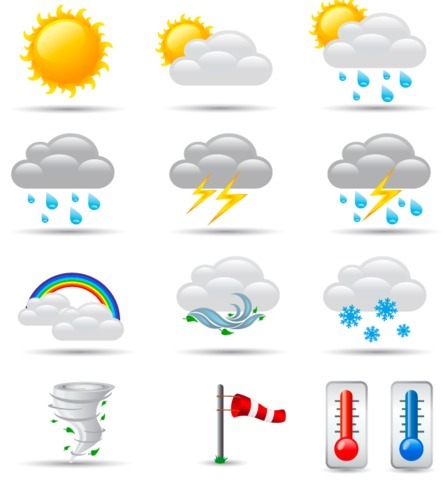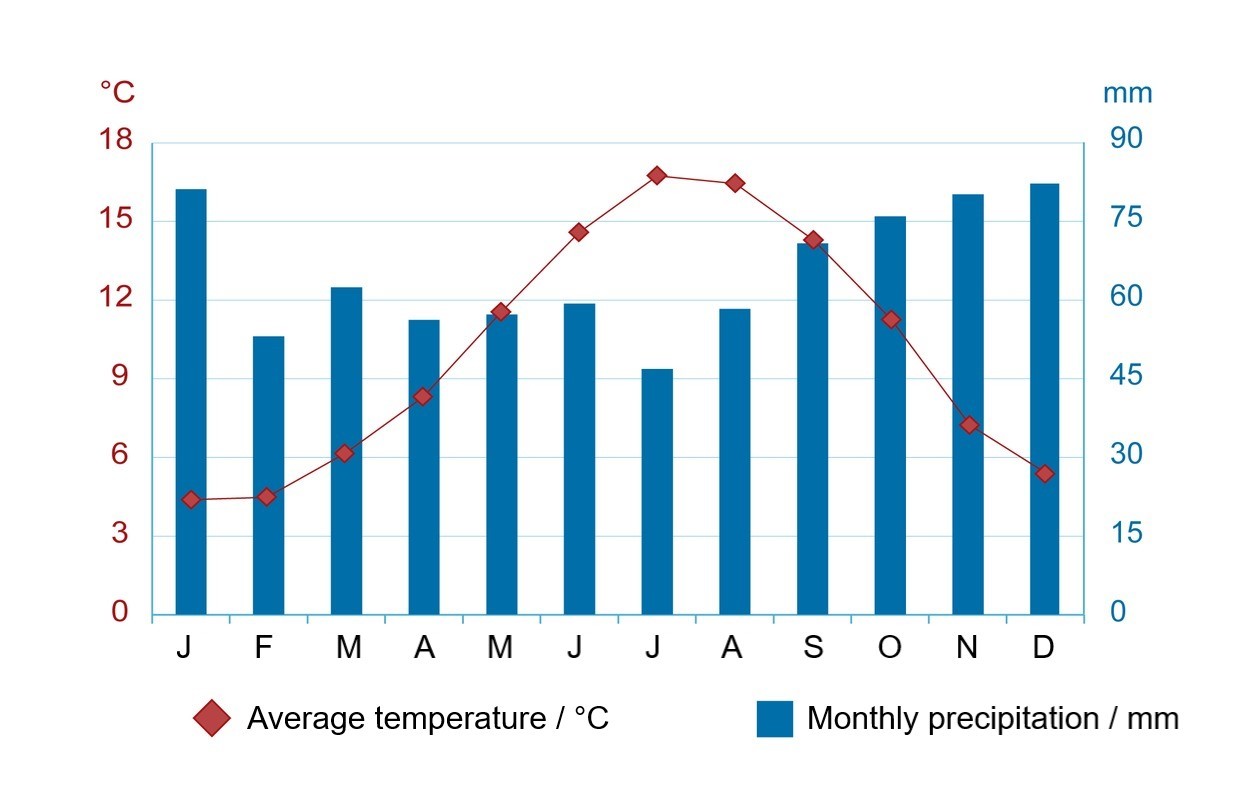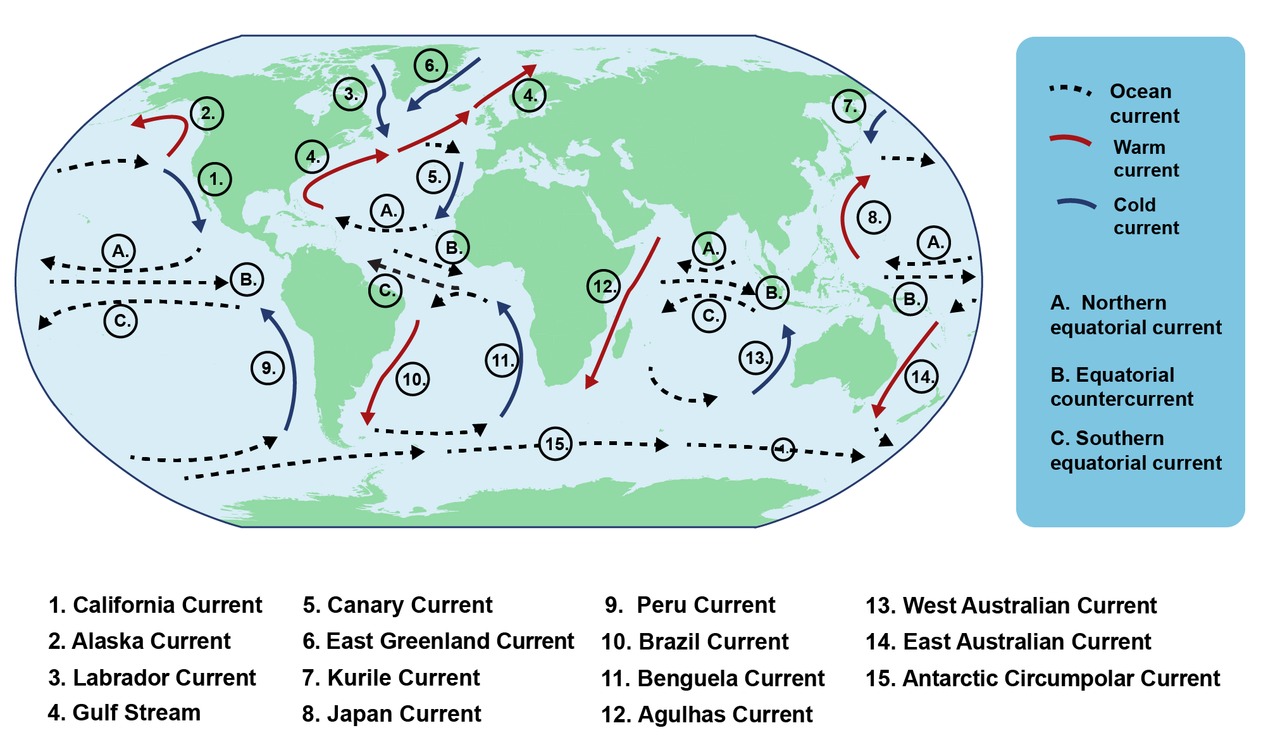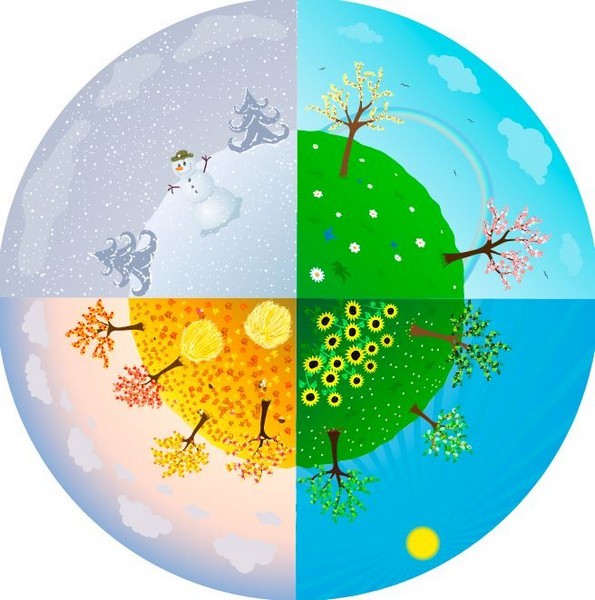8. Climate
Contents
8.1 Climate elements
 Weather changes daily, but the climate stays the same. Weather is a term that describes temporary climatic conditions, whereas climate is used to describe the long-term climatic conditions.
Weather changes daily, but the climate stays the same. Weather is a term that describes temporary climatic conditions, whereas climate is used to describe the long-term climatic conditions. When creating a climate diagram, we take the average temperatures and total amount of rainfall from each month over a sample size of 30 years. Because of the large sample size, temporary weather conditions do not have large effects on the climate diagram of a certain area. However, it can sometimes be difficult to differentiate between whether a phenomenon is a part of the weather or the climate. For example, the El Niño phenomenon can be regarded as belonging to both.
The climate of a certain region is influenced by its location relative to the Earth's equator or its latitude, its elevation and its distance from the nearest sea or ocean, as well as by the ocean currents that bring air and rainfall to the region.
The climate elements that comprise the climate of a region are the air temperature, the amount of rainfall or precipitation, the wind speed and direction, as well as the relative humidity of the air. Because atmospheric rotation causes the formation of low-pressure areas and storms to change yearly, they also have an influence on the weather and climate of a region.
| Factor | Unit |
|---|---|
| temperature | The most common unit of temperature is degrees Celsius (°C ). |
| precipitation | Precipitation or rainfall is measured in millimeters (mm) |
| wind | Wind speed is measured in meters per second (m/s). Wind direction describes the direction from which the wind arrives. |
| humidity | Relative humidity is a percentage that describes the amount of water vapor in the atmosphere compared to the maximum amount possible. Absolute humidity describes how many grams of water vapor is contained in a square meter of air. The unit of absolute humidity is gram per square meter. |
Places like the British Isles, Iceland and Norway have a maritime climate, where the winters are temperate and the summers are cool. Denmark also has this kind of a climate, which changes into a more continental climate when moving towards Fennoscandia.
 A climate diagram from London. The climate is maritime: the winters are not cold, the summer is not hot, and plenty of rainfall is experienced each month.
A climate diagram from London. The climate is maritime: the winters are not cold, the summer is not hot, and plenty of rainfall is experienced each month.8.2 The Finnish climate
The Finnish climate is influenced by three main factors. The first and most important factor is Finland's location in the Northern Hemisphere. Finland is located between the 60th and 70th northern latitudes, which means that solar radiation arrives at the surface of the Finnish earth from a slanted angle. This means that Finland receives significantly less light and warmth per square kilometer than places that are located closer to Earth's equator. As a result, Finland is part of the temperate geographic zone.
The second factor that influences Finnish climate is our proximity to the Atlantic Ocean and its warm Gulf Stream. The Gulf Stream is an ocean current that brings warm water and air from the areas near the Florida coast towards the North Sea. The Gulf Stream has a significant effect on Finnish climatic conditions, as without its warming effects our climate would be much colder and more similar to places like Siberia and Canada, which are located on approximately the same longitudes as Finland.
When southwesterly winds blow towards Finland, they bring us warm air from above the Gulf Stream. This helps to increase the average yearly temperature by approximately 6 degrees.
 The major ocean currents of planet Earth. The red arrows indicate warm currents, whereas blue arrows indicate cold currents.
The major ocean currents of planet Earth. The red arrows indicate warm currents, whereas blue arrows indicate cold currents.
The third factor that contributes to the Finnish climate is the proximity of the great Asian continent to our east. The inner parts of the Asian continent experience a continental climate. During the winter the continent grows cold, which results in easterly and northeasterly winds that bring sunny yet cold winter weather to Finland. During the summer, the Asian continent warms up slowly but surely, and southeasterly winds bring us warm summer weather.
Because the Finnish climate displays features of both maritime and continental climates, it is an example of an intermediate climate.
However, because Finland is a vast country, the climatic conditions are not same everywhere. The Southwestern parts of the nation are more temperate due to the warming effect of the Baltic Sea, which also causes the summers in these parts to be slightly colder than in inland regions.

The Finnish climate is an example of an intermediate climate. The winter is not as cold as in areas further inside the continent, but the summer is also not as warm as in these inner parts. This climate diagram presents the yearly average temperature and precipitation of the city of Jyväskylä.
The second factor that influences Finnish climate is our proximity to the Atlantic Ocean and its warm Gulf Stream. The Gulf Stream is an ocean current that brings warm water and air from the areas near the Florida coast towards the North Sea. The Gulf Stream has a significant effect on Finnish climatic conditions, as without its warming effects our climate would be much colder and more similar to places like Siberia and Canada, which are located on approximately the same longitudes as Finland.
When southwesterly winds blow towards Finland, they bring us warm air from above the Gulf Stream. This helps to increase the average yearly temperature by approximately 6 degrees.
 The major ocean currents of planet Earth. The red arrows indicate warm currents, whereas blue arrows indicate cold currents.
The major ocean currents of planet Earth. The red arrows indicate warm currents, whereas blue arrows indicate cold currents.The third factor that contributes to the Finnish climate is the proximity of the great Asian continent to our east. The inner parts of the Asian continent experience a continental climate. During the winter the continent grows cold, which results in easterly and northeasterly winds that bring sunny yet cold winter weather to Finland. During the summer, the Asian continent warms up slowly but surely, and southeasterly winds bring us warm summer weather.
Because the Finnish climate displays features of both maritime and continental climates, it is an example of an intermediate climate.
However, because Finland is a vast country, the climatic conditions are not same everywhere. The Southwestern parts of the nation are more temperate due to the warming effect of the Baltic Sea, which also causes the summers in these parts to be slightly colder than in inland regions.

The Finnish climate is an example of an intermediate climate. The winter is not as cold as in areas further inside the continent, but the summer is also not as warm as in these inner parts. This climate diagram presents the yearly average temperature and precipitation of the city of Jyväskylä.
8.3 Seasons
 The seasons can be distinguished by monitoring changes in the average temperature. The seasons change, when the daily average temperature surpasses a certain temperature. As a result, individual cold days during autumn are not yet called winter. The change between seasons can often only be seen afterwards.
The seasons can be distinguished by monitoring changes in the average temperature. The seasons change, when the daily average temperature surpasses a certain temperature. As a result, individual cold days during autumn are not yet called winter. The change between seasons can often only be seen afterwards. The number of seasons experienced in a certain area is a direct result of the area's climate. In Finland, we have four distinct seasons.
Winter is the coldest season of the year. During winter, the average daily temperature stays below zero degrees Celsius. Winter is the longest season in many parts of Finland. In Lapland, it can take up over half of each year. The southern winter begins towards the end of November and lasts approximately four months.
Winter is also much harsher in northern parts of the nation than it is in its southern parts. In addition, the northernmost parts of Finland experience the dark season of the polar night during the winter.
Autumn and spring are transitional seasons that occur between winter and summer. During both of these seasons, the average daily temperature is located between 0 and +10 degrees Celsius. In most regions of Finland, spring begins in April, but in the northernmost parts of the nation it often begins in May. The Finnish spring lasts for 1,5–2 months. The Finnish autumn begins in the middle of September in the south, and towards the August in the north. The Finnish autumn lasts for 2–2,5 months. The autumn foliage of trees and shrubs brings a splash of color to the otherwise rainy and darkening season.
Summer is the warmest month. During the summer, the average daily temperature stays above +10 degrees Celsius. It lasts for approximately four months in the southern regions of Finland, but in Lapland the summer is much shorter, lasting for only two months.
The growing season of plants begins when the daily average temperature begins to stay above +5 degrees Celsius. This is an important time for plant growth and agriculture. The growing season begins during spring and lasts all the way to autumn. The difference between the lengths of growing seasons in Northern and Southern Finland is reduced by the amount of light received in northern areas of the nation due to the midnight sun.

The four seasons.
How do marine and continental climates differ from one another? The average temperatures in February
The average temperature in different locations in the month of February. The warming effects of oceans and sea currents can be seen in the average temperatures of Vancouver and Glasgow.
The average temperature in different locations in the month of February. The warming effects of oceans and sea currents can be seen in the average temperatures of Vancouver and Glasgow.
8.4 The climate is changing
 The climatic conditions of planet Earth have changed drastically throughout its history. As a result of these changes, Finland has experienced various kinds of different climates even after the last Ice Age.
The climatic conditions of planet Earth have changed drastically throughout its history. As a result of these changes, Finland has experienced various kinds of different climates even after the last Ice Age.The planet's average temperature has increased by approximately half a degree over the course of the last hundred years. The main causes behind this change have been in the actions of humans.
Earth's temperature is rising because of an accelerated greenhouse effect in the planet's atmosphere. The greenhouse effect is caused by various atmospheric gases, such as water vapor, carbon dioxide and methane. These gases, also known as greenhouse gases, let solar radiation penetrate the planet's atmosphere but prevent heat radiation from escaping it. These gases act like the glass walls of a greenhouse: they let light and heat in, but do not let heat escape out.
The use of fossil fuels, such as oil and coal, has increased the amount of carbon dioxide in the planet's atmosphere since the 19th century. In addition, the methane produced by livestock has also increased in the atmosphere due to the rise of factory farming. As the amount of greenhouse gases in the atmosphere has increased, the greenhouse effect has begun to accellerate. This has caused more heat to be trapped inside the planet's atmosphere, and the average temperature of the planet has begun to increase.
The Finnish climate has been estimated to grow warmer by 2–3 degrees Celsius by the year 2050. This change will be visible particularly during the winter season. As a result of this change, winters will become warmer and less snowy, especially in the southern and western parts of the nation. As the Finnish summer temperatures grow warmer, the vegetation of our forests will also change. The amount of broadleaf trees will increase, and new plant and animal species will spread to Finland from the south.
Climate data from Finland
| Helsinki | Jyväskylä | Kauhava | Joensuu | Oulu | Sodankylä | |
|---|---|---|---|---|---|---|
| January | -4 | -9 | -8 | -10 | -11 | -14 |
| February | -5 | -9 | -8 | -10 | -11 | -12 |
| March | -2 | -4 | -4 | -5 | -5 | -8 |
| April | 3 | 1 | 2 | 1 | 0 | -2 |
| May | 10 | 9 | 9 | 8 | 8 | 5 |
| June | 15 | 14 | 14 | 14 | 13 | 12 |
| July | 17 | 16 | 16 | 17 | 16 | 14 |
| August | 16 | 14 | 14 | 14 | 13 | 11 |
| September | 11 | 8 | 8 | 9 | 8 | 6 |
| October | 6 | 3 | 4 | 3 | 2 | -1 |
| November | 1 | -2 | -2 | -3 | -4 | -8 |
| December | -2 | -6 | -6 | -8 | -9 | -12 |
| Average | 6 | 3 | 3 | 3 | 2 | -1 |
| Helsinki | Jyväskylä | Kauhava | Joensuu | Oulu | Sodankylä | |
|---|---|---|---|---|---|---|
| January | 47 | 43 | 29 | 44 | 29 | 35 |
| February | 36 | 32 | 23 | 34 | 24 | 29 |
| March | 38 | 40 | 24 | 36 | 25 | 29 |
| April | 36 | 31 | 26 | 35 | 26 | 28 |
| May | 32 | 28 | 33 | 37 | 38 | 35 |
| June | 49 | 54 | 50 | 67 | 61 | 57 |
| July | 62 | 63 | 71 | 75 | 67 | 63 |
| August | 78 | 81 | 61 | 80 | 82 | 61 |
| September | 66 | 67 | 57 | 62 | 56 | 47 |
| October | 73 | 67 | 45 | 60 | 47 | 50 |
| November | 68 | 61 | 43 | 59 | 42 | 40 |
| December | 58 | 58 | 32 | 54 | 35 | 35 |
| Average | 54 | 52 | 41 | 54 | 44 | 42 |
| Total | 643 | 625 | 494 | 643 | 532 | 509 |